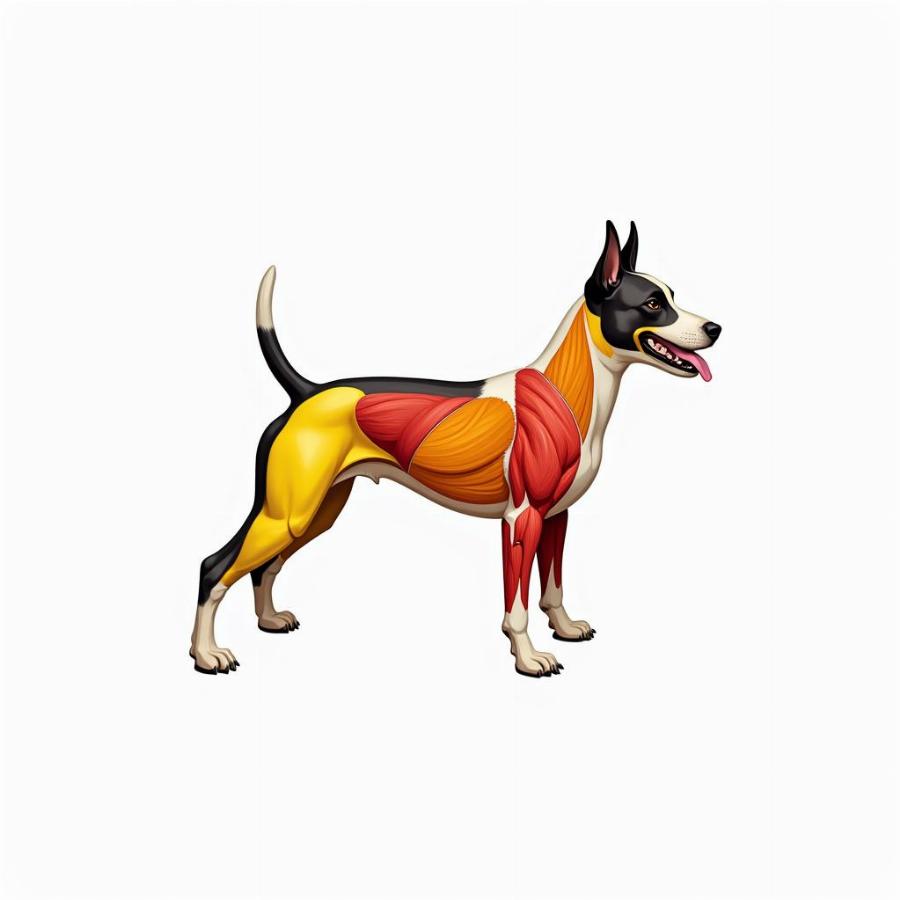Muscles in dogs, much like in humans, are the engines that power their every move, from a playful bound across the park to a gentle nudge for a head scratch. Understanding the intricate network of muscles in dogs is crucial for every owner, as it provides insights into their physical capabilities, potential health issues, and overall well-being. This knowledge empowers owners to make informed decisions about exercise, nutrition, and even early detection of potential problems.
The Canine Muscular System: A Complex Network of Power and Grace
The canine muscular system is a complex network comprising hundreds of muscles, each playing a specific role in movement, posture, and bodily functions. These muscles are broadly categorized into three types: skeletal, smooth, and cardiac. Skeletal muscles, responsible for voluntary movements like running and jumping, are what we typically associate with “muscles in dogs.” Smooth muscles, found in internal organs like the stomach and intestines, control involuntary functions like digestion. Cardiac muscle, unique to the heart, powers the circulatory system. Understanding the distinction between these muscle types is key to appreciating the multifaceted nature of muscles in dogs.
Major Muscle Groups in Dogs and Their Functions
 Các nhóm cơ chính ở chó
Các nhóm cơ chính ở chó
Several key muscle groups contribute to a dog’s athleticism and overall health. The pectorals and latissimus dorsi power the front legs, enabling strong pulling and paddling motions. The biceps and triceps work in tandem to flex and extend the elbow. In the hindquarters, the gluteals, quadriceps, and hamstrings propel the dog forward, providing the driving force for running and jumping. Back support for dogs is crucial for maintaining a healthy posture and preventing injuries, particularly as they age. You can find more information about back support for dogs on our dedicated page: back support for dogs.
How Do Muscles in Dogs Work?
Muscles in dogs work through the intricate interplay of muscle fibers, tendons, and bones. When a dog decides to move, the brain sends signals to the relevant muscles. These signals trigger the muscle fibers to contract, pulling on the tendons which, in turn, move the bones. The coordinated action of multiple muscle groups allows for a wide range of movements, from the delicate movements of the face and ears to the powerful strides of running. Can dogs have sore muscles? Absolutely. Just like humans, dogs can experience muscle soreness after strenuous activity. Learn more about this on our page: can dogs have sore muscles.
Keeping Your Dog’s Muscles Healthy
Maintaining healthy muscles in dogs requires a holistic approach encompassing proper nutrition, regular exercise, and preventative care. A balanced diet rich in protein provides the building blocks for muscle growth and repair. Regular exercise, tailored to the dog’s breed and age, helps maintain muscle tone and strength. Epaxial muscles, essential for back and spine health, benefit greatly from targeted exercises. Learn more about these specific muscles: epaxial muscles dog.
Dr. Emily Carter, a renowned veterinary physiotherapist, emphasizes the importance of regular exercise: “Just like us, dogs need regular physical activity to keep their muscles strong and healthy. A sedentary lifestyle can lead to muscle atrophy and a host of other health problems.”
Regular check-ups with a veterinarian can help identify and address any potential muscle-related issues early on. Salmon is a great source of Omega-3 fatty acids, which can help support muscle health in dogs. You can learn more about the benefits of salmon for your dog here: salmon for dog. Remember, a proactive approach to muscle health is crucial for ensuring your canine companion enjoys a long and active life.
Conclusion
Understanding the intricacies of muscles in dogs is paramount for responsible ownership. From the powerful leg muscles that propel them forward to the delicate facial muscles that convey their emotions, every muscle plays a vital role. By providing proper nutrition, adequate exercise, and regular veterinary care, we can ensure our canine companions maintain optimal muscle health and enjoy a vibrant, active life.
FAQ
-
What are the main types of muscles in dogs?
- Skeletal, smooth, and cardiac.
-
What are the key muscle groups in a dog?
- Pectorals, latissimus dorsi, biceps, triceps, gluteals, quadriceps, and hamstrings.
-
How can I keep my dog’s muscles healthy?
- Provide a balanced diet, regular exercise, and routine veterinary care.
-
Can dogs experience muscle soreness?
- Yes, just like humans.
-
What is the importance of epaxial muscles in dogs?
- They support the back and spine.
-
What are some good exercises for my dog’s muscles?
- Consult your veterinarian for a tailored exercise plan.
-
What are the signs of muscle problems in dogs?
- Lameness, stiffness, pain, and swelling.
Beaut Dogs is a comprehensive resource for all things dog-related, from breed information to health and training tips. We are passionate about providing valuable information to dog lovers everywhere. When you need assistance, feel free to contact us via Email: [email protected] for detailed and accurate information from Beaut Dogs. Visit us at https://beautdogs.com for more information on caring for your canine companion.